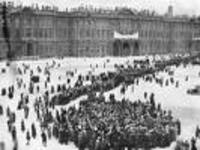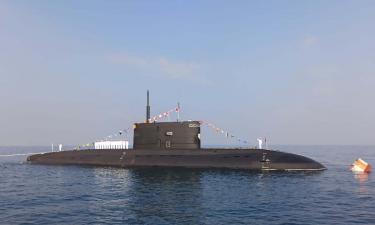The Russian Revolution: 90 years on. An analysis
It would be perhaps more correct, from a historical viewpoint, to remember the centennial of the First Revolution of 1905/7 while we celebrate the 90th anniversary of the Great Socialist Revolution, whose implications were vast and whose objectives were victoriously achieved, both in Russia and in the internationalization of the Socialist ideals.

Lenin died and went to Hell. Three days later, the Devil, desperate, telephoned Saint Peter, begging for an exchange. "This one here has already unionized the demons, nobody is working…I can’t carry on like this!" They made the exchange and two days afterwards, the Devil telephoned again to see how things were going. "So then? How is God getting on with that Lenin?" “God??" answered Saint Peter. "He doesn’t exist!"
In the joke, Lenin paralyzed Hell and revolutionized Heaven. On Earth, Vladimir Ilyich Ulyanov (b. 22nd April 1870 in Simbirsk/Ulyanovsk), was the motor, with others, of the Great Socialist Revolution of October (25th October in Julian calendar, at the time followed in Russia/7th November in the Gregorian calendar).
The context of the Revolution
To analyze the meaning of the Revolution, one has to examine its social and historical context. Russia and the Russians were stagnated, constrained by feudal-slavery vectors which blocked technical, economical and social development. The entire country was caught between the teeth of the vice of capitalists and landowners on one hand and of the despotism of Tsarism on the other.
In 1917, 28,000 feudal landlords owned as many hectares of land as 10 million peasants (around 70 m. ha.). Output was concentrated in the hands of monopolies, in their turn connected to the group in power.
Already in 1905/7, the First Revolution, brutally repressed, had shown signs that the pressure cooker (that had been boiling for half a century – the oldest brother of Lenin was hanged in 1887 for conspiring against Tsar Aleksandr III) would burst. The autocracy of the regime in the counter-revolutionary years that followed (1907-1914), whose visible symptoms were the stupidity and ineffectiveness of the Tsarina, Aleksandra, the monstrous Rasputin and the First World War, in which the Russian Army was decimated - the continuation of which favoured the interests of the beorgeoisie.
The struggle between the middle class (whose power increased at the expense of the exhausted and emaciated monarchist system) and on the other hand, the proletariate/peasants/armed forces, resulted first in the uprising of Central Asia (1916) and during the following year, tension in the cities (which had the highest concentration of workers in the world) through strikes, and in the countryside, where the estates of the landowners were pillaged. This tension resulted in the Revolution of February/March 1917, culminating in the abdication of Tsar Nicolas II on 2nd March.
Between Two Revolutions
Between March and November, the Provisional Government, led first by the reformist Prince Lvov and afterwards by Aleksandr Kerensky of the Social Revolutionary Party, tried to impose itself over powerful social movements. However, the workers’ Soviets established in 1905/7 in many Russian cities remained active and these elected the Soviet of the Representatives of the Workers of Petrograd, in February 1917, led by the Mencheviks and Revolutionary Socialists.
The Soviet met in the Tauride Palace, where the Provisional Government also tried to forge its reformist policies, making an effort to please everybody and avoid a situation of duality of power, dvoevlastie, in Russian. However, it was this that happened and during the arm-wrestle that followed, the policies of the Soviet (democratic reforms, implementation of the Republic, civil rights, abolition of ethnic and religious discrimination, elections to choose a Constituent Assembly) earned more support among the people, with whom the Soviet identified itself better than Kerensky, the young lawyer, and the bourgeoisie in his government.
In the hearts of the people, the Provisional Government was considered responsible for the catastrophic situation experienced by most of the population, mainly due to the continuation of the war and to its disastrous consequences. Kerensky’s "new offensive" (Minister of War and afterwards Prime Minister) failed and in general, his reforms were too late and too little. The release of the political prisoners did not contribute towards alleviating the suffering of the people, whose energy was channeled into several political factions, which had as their common cause the undermining of the Government’s authority.
Lenin’s Return
It was then that Lenin, exile in Switzerland, decided to come back to Russia, arriving in Petrograd in April 1917. His presence gave strength and more popularity totheBolsheviks (his faction) and their influence was increased by electoral victories in the Soviets of Petrograd and Moscow. His manifesto was simple: "Peace, land and bread".
In July, an attempted coup failed against Kerensky and Lenin was exiled to Finland; however, the mechanism of the Revolution was already implanted and set in motion.
Another attempted coup in August, this time by General Lavr Kornilov (who wished to re-establish the monarchy) saw Kerensky forced to seek the help of the Petrograd Soviet and the Bolsheviks. On 10th October, the Bolsheviks’ Central Committee approved a motion to remove the Provisional Government, based on its incapacity to implement policies which satisfied the people, who in their turn, frustrated with the Mensheviks and Revolutionary Socialists in the Provisional Government, looked more and more towards Lenin.
On 7th November 1917 (Gregorian calendar) Vladimir Lenin led the Bolsheviks in the Russian Revolution, achieving a victory against the Provisional Government, installing the Soviets (advisors elected by the proletariat and peasants) as instruments of Government.
Significance of the Russian Revolution
There followed several years of military and political turbulence, despite the peace treaty with Germany (Brest-Litovsk, 3rd March 1918): the Tambov Rebellion (1919-1921), the Kronstadt Rebellion (1921) and the Civil War (1918-1922). However, when Lenin died in 1924, the power of the Bolsheviks and Revolutionaries was implanted in Russia.
In the following years, the manifesto of Peace, Land and Bread was brought to fruition. The destruction of autocracy and one of the ugliest capitalist regimes the world has ever known was translated into a secure state which guaranteed universal access to free, high-quality public services: a system of high-quality education, equality of opportunity and social mobility, the right to a job, accommodation, healthcare, energy, transportation and communications, leisure time activities and retirement pensions with all basic needs guaranteed.
Those who paint a black and negative picture of the Russian Revolution, invoking Stalinist purges and the murder of Trotsky (Stalin and Trotsky being two pillars on whose shoulders the success of the revolution also lies), are guilty of biased historical revisionism. The history of the Revolution must be separated from the social vectors which have always existed in all societies.
To blame the Revolution and Socialism/Communism for the developments in the following years (in which the enemies of Russia and of the globalised internationalist movement of the proletariat/peasants spent trillions of dollars trying to sabotage the model) makes as much sense as blaming Capitalism for the systematic extermination of the native peoples of the United States of the America, the nuclear terrorism in Hirosima or Nagasaki, as much sense as blaming British parliamentary “democracy” for massacres in Ireland, Scotland, Wales or India.
The internationalization of the revolutionary movement culminated in the freedom of peoples oppressed by the yoke of the western powers’ Imperialism/Colonialism and in the implementation of reformist and developmental policies which, as happened in Russia, led backward and underdeveloped societies to the front line, guaranteeing for the first time systems of high quality and free public services, which the world’s societies continue to yearn for today.
The shockwaves provoked by the Revolution shook those who held the world’s capital while simultaneously galvanizing the trade union movements. Today, 100 years since the First Revolution and 90 since the Great Socialist Revolution, it can be stated that all of Lenin’s main objectives were carried out in full, both in Russia and in the World.
The peaceful transformation, without complexes, of the USSR into the Commonwealth of Independent States, foreseen in Soviet law, was wintness of the success of Lenin’s project: 70 years after his death, any Soviet citizen was in a position to dispute any job in any field, with anyone else anywhere in the world, on an equal footing and today, the Russian Federation continues to be an invincible super-power which guarantees the rights and opportunities it affords to its citizens.
The Russian Revolution showed that a Socialist political path is possible and that the construction of a society based on social policies which aim at the construction of a Communist state can be implemented successfully, that public services can be supplied by a State and not necessarily by the private sector. It is an example for the future, when the capitalist-monetarist model, which only perpetuates itself by looting resources and imposing hypocritical mechanisms (subsidies, sanctions and tariffs) implodes.
Timothy BANCROFT-HINCHEY
PRAVDA Ru
Subscribe to Pravda.Ru Telegram channel, Facebook, RSS!




